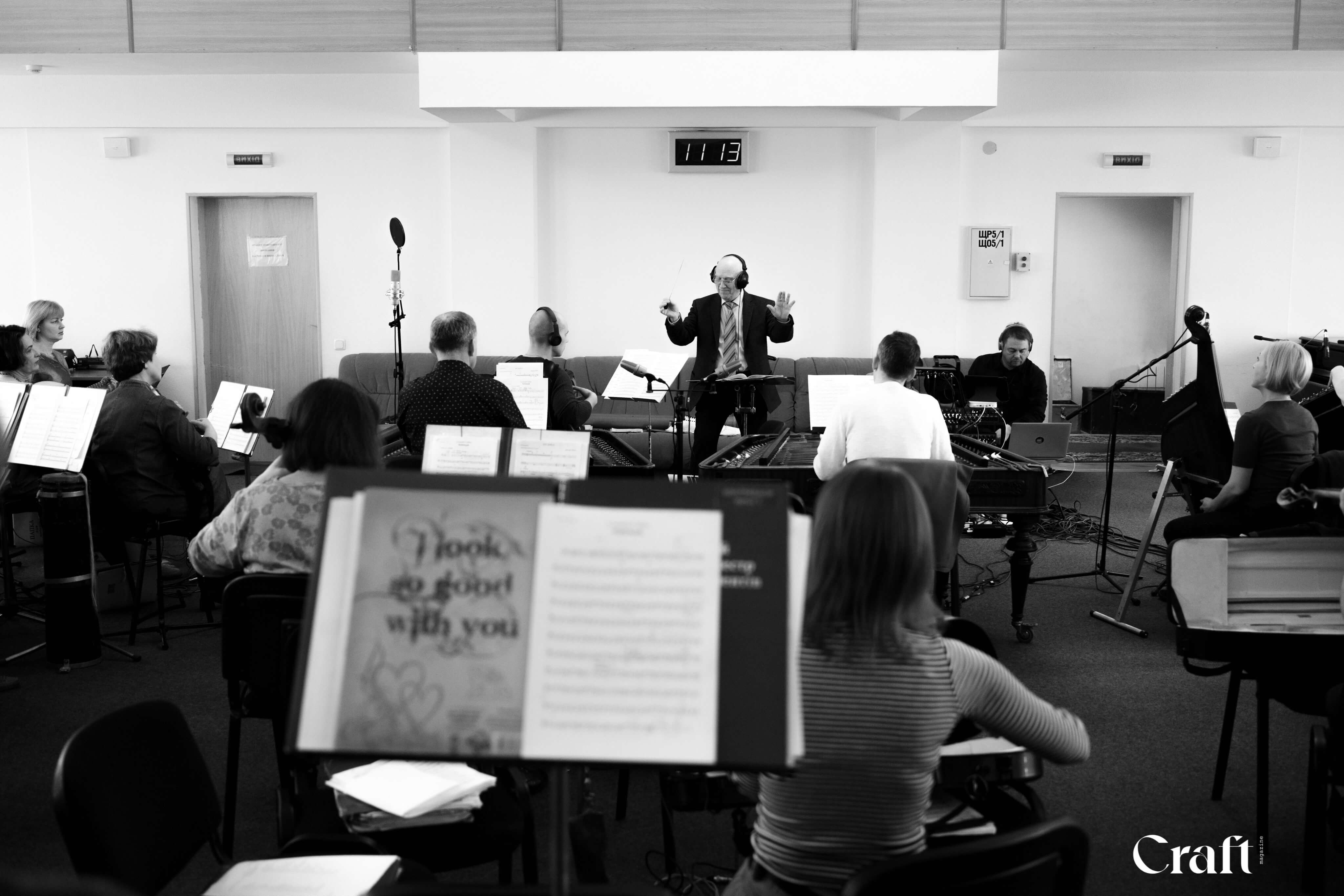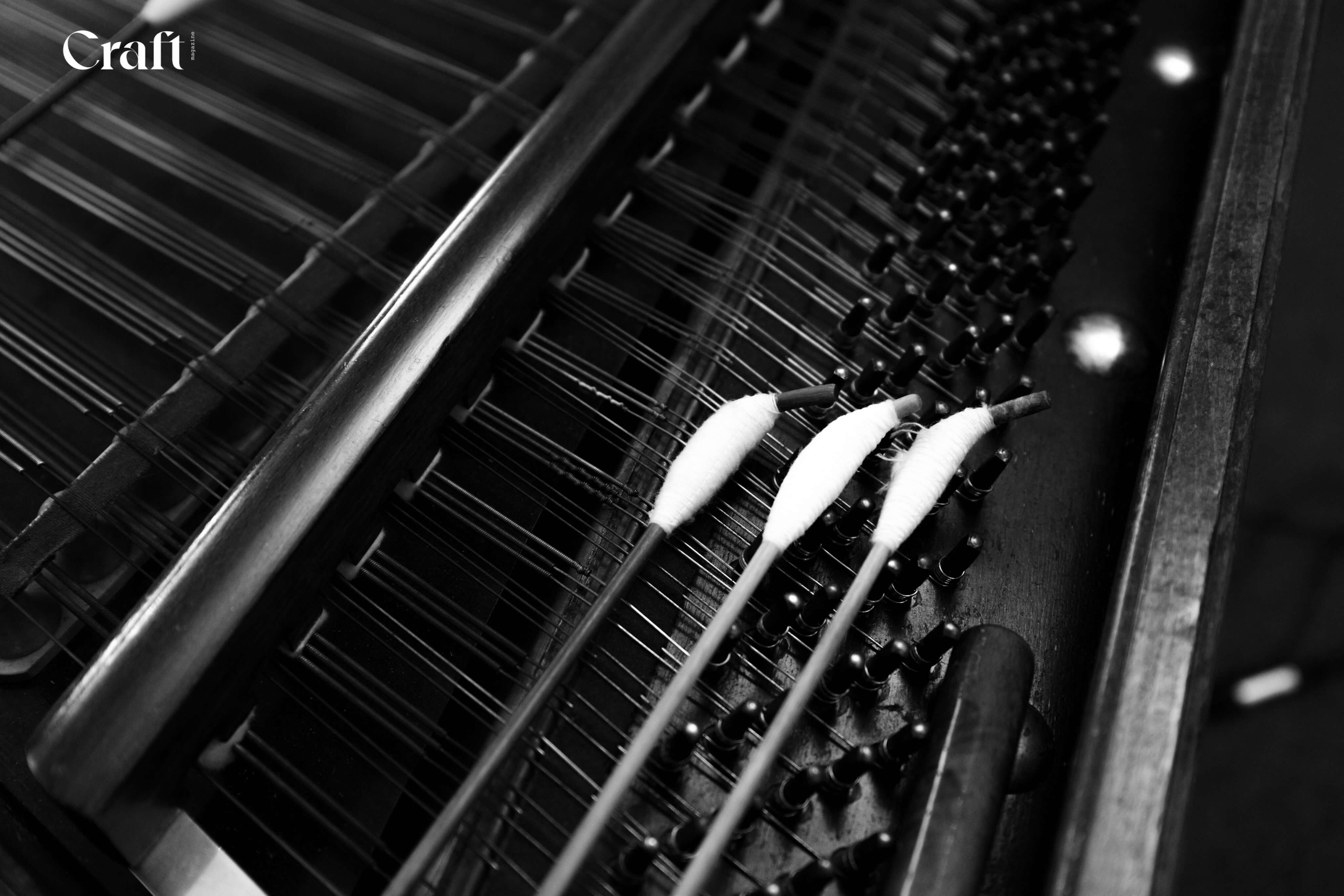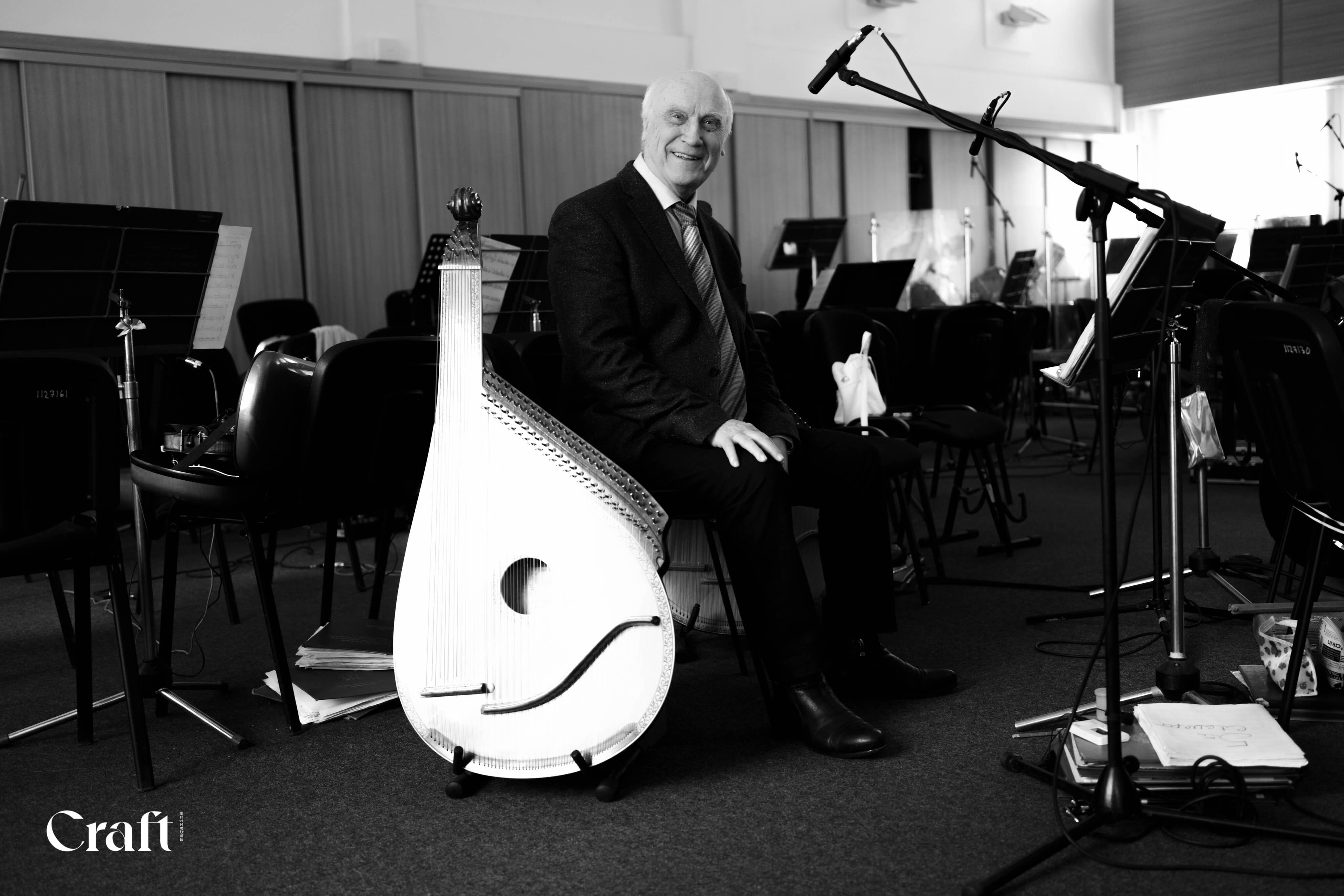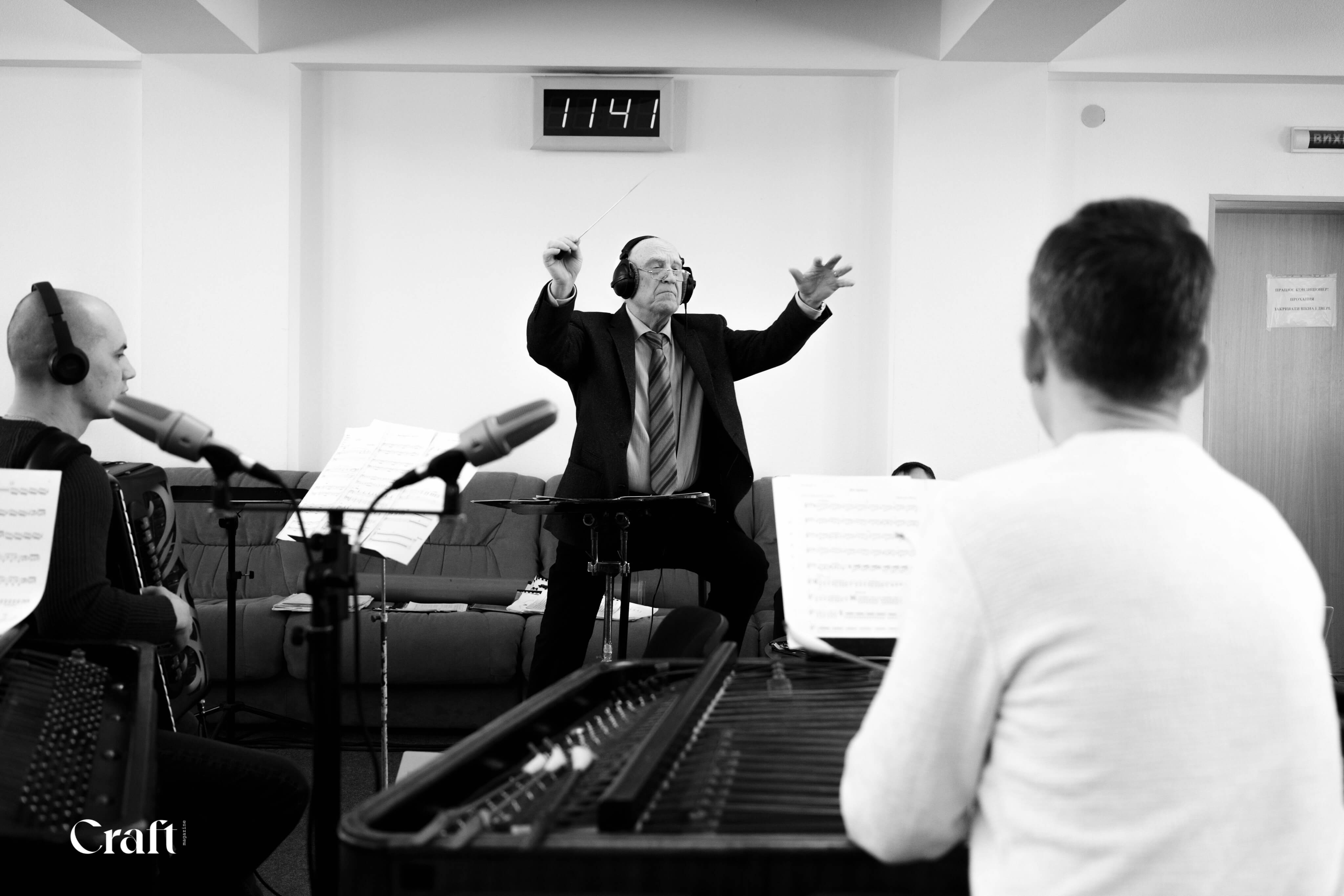Viktor Hutsal is a conductor, composer, and musicologist. Since 1984, he has served as the artistic director of the National Academic Orchestra of Folk Instruments (NAONI). He is the founder of the Department of Bandura and Kobzar Art at the National University of Culture and Arts, the secretary of the All-Ukrainian Music Union, and the head of the Association of Folk Instrumental Music of Ukraine.
He has authored over 500 orchestrations, arrangements, and original compositions, including the widely recognized adaptation of the Zaporizhian March. He has also composed music for films, notably The Lost Letter and Oh, Don’t Go, Hrytsiu.
A People's Artist of Ukraine, he was awarded the Taras Shevchenko State Prize in 1992.
The project "Strengthening Independent Media for a Strong Democratic Ukraine" implemented by DW Akademie in cooperation with Lviv Media Forum and Ukrainian Public Service Media, Suspilne, is funded by the European Union and co-supported by the German Federal Foreign Office.
What prompted the rethinking of the National Academic Orchestra of Folk Instruments and the emergence of the NAONI brand — was it time, an event, or a trend?
— We needed to find a path to recognition. After all, what is a brand? It encapsulates all our positive qualities. We had worked on the orchestra’s quality for a long time, but we needed a concise presentation. In the end, it turned out to be simple: NAONI is our abbreviation. To say that we pondered this problem for a long time — no, we didn’t.
The most important thing for our ensemble is our skill and repertoire — this is what captivates our listeners. The brand simply helps with that. People say a new brand means new quality, but we always strive to maintain the highest quality.
Along with this renewal came openness to the public.
— That was the second stage — bringing the brand to the people. I believe we are the first ensemble with a long history to achieve popularity under a brand name.
When it comes to national ensembles like yours, there are usually two opposing opinions. One side says you have unfair privileges because you receive state funding when you should be making a profit and operating like a business. The other argues that you should maintain an elite status and not "sell out" for entertainment. NAONI performs a mix of programs — your lineup includes everything from large-scale shows to collaborations with rock musicians and film score adaptations. Have you ever been accused of "commercializing" your work?
— We don’t just play for the sake of art — we also have to think practically. In a way, what we do is commercial. Our music is something we bring to people, so we have to play what resonates with them. But at the same time, we stay true to ourselves, our vision, and our style. It’s all about balance.
We’ve built a diverse repertoire over the years, but we’re always looking for new material.

People often say that the conductor is the brain of the orchestra. In your case, you’re also the artistic director and have been leading NAONI for a long time. You bring in guest conductors and refresh the repertoire to keep things dynamic. But on a personal note — do you ever feel burned out?
— There’s a saying: when you love what you do, it doesn’t feel like work. And that’s exactly how I feel — I’ve never thought of it as just a job.
What does folk music mean to you? Unlike other national ensembles, NAONI keeps expanding its repertoire, but you still stay deeply connected to folk traditions, especially given your instrumentation.
— I might sound a little pompous, but I truly believe folk music is in our DNA — not just mine, but all of ours. It’s always been there; we just need to tap into it. That’s the foundation of our orchestra, even though our repertoire is incredibly varied. We also make a point of playing music from all regions of Ukraine.
These days, people are drifting away from their roots. In Western Europe, folk traditions have nearly disappeared. We can’t let that happen here — we can’t lose ourselves in global trends and become something generic. Folk music is what makes us who we are.
Of course, we live in a modern world, and we embrace contemporary influences that resonate with us. But we never forget where we come from. People love us because we play on traditional instruments, and that authenticity is so strong that even when we perform foreign music, it still feels Ukrainian. That’s what makes us stand out.
You’ve often mentioned that NAONI has an incredibly rich variety of timbres, largely thanks to the diversity of folk instruments.
— We have over 40 different types of Ukrainian musical instruments — that’s 40 distinct timbres. And if you consider how they interact with each other, the number of possible combinations is enormous.

How did you choose which reconstructed instruments to include in the orchestra? Given the many regional variations, that must have been quite a challenge.
— It’s been a long process — we’ve been collecting these instruments for over 50 years. First, we reconstruct them. Some were revived almost from scratch, like the Cossack trumpet or the surma-horn. An instrument has to be properly refined before it can be used in contemporary music, or in music at all.
Take the sopilka, for example. There are versions with five holes, six, seven, even eight. Over time, through years of experimentation, craftsmen developed a unique, standardized version that can play anything in any key, at any tempo, with any fingering.
The same goes for the bandura, the tsymbaly, or the kobza. There are many variations, but in the end, we arrived at a universally recognized design that allows for complex orchestral arrangements. Even composers like Liszt and Stravinsky incorporated the tsymbaly into their works.
These days, folk instruments are making a strong comeback in Ukraine. You can see it even in Eurovision — almost every performance features some element of traditional instrumentation.
— Ukraine has made a name for itself at Eurovision, sending more artists than almost any other country who incorporate elements of folk music into their performances.
And it’s great to see that Ukrainians continue to support and celebrate these artists' successes.
Speaking of the bandura — there’s been debate about whether we should abandon the version we’re used to, since it was standardized during Stalin’s era and, some argue, was used for propaganda and fakelore (ukr— 'sharovarshchyna'). Instead, they suggest returning to its earlier forms. What’s your take on that?
— Honestly, I think that’s complete nonsense and a simplistic way of looking at history. Masters like Korniyenko, Khotkevych, Skliar, and Herasymenko were shaping the bandura even during Stalin’s time. Some, like Hnat Khotkevych, were executed for their work. Each of them introduced new elements to the instrument, pushing it forward rather than letting it stagnate. The reality is, people had to survive and create under Stalin’s regime, and despite the repression, the bandura evolved. We need to recognize that and form our own perspective accordingly.
The bandura didn’t gain its significance by accident — it became popular because people embraced it, not because it was forced from above. That’s why it found its place in orchestras. Instead of rejecting it, we should proudly carry forward the legacy of those who dared to keep the tradition alive, even in the darkest times.

You incorporate everyday objects into your performances — for example, turning an ordinary farming scythe into a percussion instrument. We’re used to seeing this in amateur folk groups, but your approach is based on research. Is this just for show, or did traditional musicians actually use household items in their music?
— Folk instruments have always originated from everyday life. The same goes for the scythe, the washboard, the rolling pin, the berbenytsia, the bugai, and many others. Resourceful people found ways to use them for entertainment as well. Even the kobza started off as a simple instrument with just a few strings, but as musicians sought greater expression, they kept adding more. That’s how folk instruments evolve — through innovation and adaptation.
Since folk music is at the heart of your repertoire, do you curate special programs for international audiences?
— We’re currently preparing for a tour in Germany, and we’re deliberately not bringing anything they’re already familiar with. Let’s be honest — foreign audiences enjoy hearing music they recognize, which makes sense because familiarity builds trust.
But our goal is to surprise them — with the richness of Ukrainian folk music as arranged by contemporary composers, with our unique style and performance. That’s what truly matters.
I’ll say it again — folk music resonates most deeply with its own people. And honestly, I’m often amazed by our audiences in Ukraine. Just recently, we performed in Fastiv, and I was blown away by how deeply people connected with the music — they were shouting in the middle of the concert, overwhelmed with emotion. I’m incredibly proud, not just of our orchestra, but of the people who embrace us with such passion. And today, coming to a concert is an act of bravery. We’ve been welcomed so warmly in Zaporizhzhia, Kremenchuk, and Poltava — places where people are terrorized by russian drones and missiles every day. Yet, they still come to the concert hall and wait for the performance, sometimes for hours — just like we wait with them for the air raid alarms to end. That kind of resilience is truly inspiring.
After so many years leading the orchestra, I can only imagine the challenges you’ve faced. But I want to ask about doubt — have you ever felt like you were heading in the wrong direction?
— The only doubt I have is how much harder it’s becoming for us to keep going. Everything is changing, especially in terms of attitudes. I wish there were more understanding from organizations and individuals who are supposed to promote Ukrainian art. There should be more support at the state level — we expect it, but it’s not always there.
You’ve spoken before about how the orchestra endured the early days of the full-scale war in 2022, when many of your female musicians had to flee abroad with their children. All concerts were canceled, and you took your music directly to the people — literally performing on the subway. Later, you mentioned that artists need this kind of closeness to an audience that may not even know who they are.
— And I still believe that. A musician has to feel everything, especially how people react to them. They can’t just be polished performers focused solely on virtuosity. No — they need to step out and see how their music is received, to prove what they can do. That’s the best kind of training. I’m not saying anything revolutionary here. Today, we can tell the truth about the Soviet Union, and there’s plenty to criticize. But back then, musicians were required to perform in tiny, unknown towns and villages, where they had to survive and work. And that was a valuable experience.
So I think it was absolutely right for us to play concerts on the subway and to hold impromptu online performances. It made us stronger.
You regularly recruit new members for the orchestra. Beyond technical skill and knowledge of the repertoire, do you have any additional requirements for musicians?
— The most important requirement is to be a true patriot of Ukrainian music. That’s something they don’t teach in conservatories. There, the focus is on classical training, and then in real life, musicians don’t even know how many Ukrainian folk songs exist, or the different genres of folk instrumental music. They have to start learning from scratch and develop a feel for it. Some just can’t connect with folk music at all. But others fall in love with it and stay with it for life.
Playing just to "get the job done" doesn’t fly with us. If you're part of this orchestra, you have to give yourself fully to the music and its unique style.

What’s your secret to managing such a large ensemble? We all know how complicated relationships in theater or even in a choir can be — people with different personalities and ambitions. How do you handle that?
— No doubt, it’s a challenge. In my book, I outlined the qualities a conductor must have, especially if they’re also the artistic director. That includes knowledge of psychology and pedagogy.
But above all, every ensemble needs a unifying idea. It might seem like a simple question: Why do we exist? What is our purpose? But when a musician truly understands and respects that, when they strive to go beyond their limits, then they truly belong in the NAONI Orchestra — and they’ll never leave unless forced to by extraordinary circumstances, like war. It’s this shared purpose and love for what we do that binds us together. Yes, the conductor sets the tone, but the musicians follow, united by that vision.
Of course, interpersonal conflicts happen, but they should never affect our work. I always remind my musicians that we live by and through our work. And especially during tours, we are, in many ways, a family.
That’s why, when people say you can form an orchestra in a week, I don’t believe it. Sometimes I hear about musicians coming together, calling themselves an orchestra, and promoting performances abroad. I just don’t understand that. A true orchestra takes years, even decades, to build. A real orchestra is a solid unit — artistically, creatively, and personally.
Translated by Anna Petelina
Viktor Hutsal is a conductor, composer, and musicologist. Since 1984, he has served as the artistic director of the National Academic Orchestra of Folk Instruments (NAONI). He is the founder of the Department of Bandura and Kobzar Art at the National University of Culture and Arts, the secretary of the All-Ukrainian Music Union, and the head of the Association of Folk Instrumental Music of Ukraine.
He has authored over 500 orchestrations, arrangements, and original compositions, including the widely recognized adaptation of the Zaporizhian March. He has also composed music for films, notably The Lost Letter and Oh, Don’t Go, Hrytsiu.
A People's Artist of Ukraine, he was awarded the Taras Shevchenko State Prize in 1992.
The project "Strengthening Independent Media for a Strong Democratic Ukraine" implemented by DW Akademie in cooperation with Lviv Media Forum and Ukrainian Public Service Media, Suspilne, is funded by the European Union and co-supported by the German Federal Foreign Office.